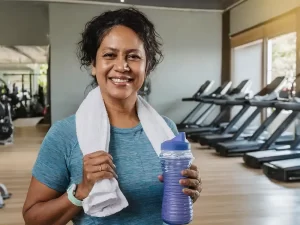My Grandma used to say cleanliness is next to godliness, mostly because she wanted us to wash our hands after playing outside. She also referred to it when talking about keeping her house clean and tidy, which she believed was her role as a woman. Now, we’ve obviously moved on from stereotypical views of women as the cleaner and housekeeper. There are certainly more men who are helping out with the housework. But the reality is that women still spend more time in the home breathing in cleaning products.
Unfortunately, this puts them at more risk of far more serious health conditions – including cancer – than people who don’t spend as much time at home. And if you’re like me and live in NSW or even Victoria you’re probably spending a lot of time in your home right now. So, three questions to think about… Firstly, what are you cleaning your house with? Secondly, is it affecting your health or the health of your family? And finally, is there a better way?
Research on cleaning products
A study published in the journal Environmental Health in 2010 showed the link between frequent use of household cleaning products and an increased risk of breast cancer. Julia Brody, PhD, from the Silent Spring Institute in Newton, Mass., says air fresheners and products used to control mould and mildew are major culprits. The researchers conducted telephone interviews with 787 women diagnosed with breast cancer and 721 women who did not have breast cancer.
“We asked women about past use of cleaning products — in the past year, their typical use,”
Brody says.[1]
Breast cancer risks were twice as likely to appear with women who use toxic cleaning products and air fresheners the most. Users of solid air fresheners and mildew and mould control products had a 70% increased risk.
It’s not just women who clean their own homes either. Women in the cleaning industry who are exposed to cleaning chemicals on a regular basis are at a greater risk of breast cancer. Furthermore, cleaning chemicals and air fresheners have been the subject of a lot of breast cancer research because many of their ingredients contain endocrine disrupting compounds. Some compounds also affect growth of oestrogen–receptive human breast cancer cells.[2]
So, what are the chemicals in your cleaning products that you should look out for and avoid?
Chemicals in cleaning products that contribute to increased breast cancer risk are:
- Alkylphenols – are found in detergents and other cleaning products. This chemical is an endocrine disruptor that alters mammary gland development in rats.
- Synthetic musks – found in fabric softeners, detergents and air fresheners, prevents cells from blocking toxins in animal study.
- Phthalates – found in air fresheners, household cleaners and plastics. Endocrine disruptor and may cause organ damage and cancer.
- Formaldehyde – found in spray and wick deodorizers and air fresheners is a suspected carcinogen.
- Terpenes – used in household cleaners and air fresheners with pine, lemon and orange scents. Terpenes produces toxic chemical substance similar to formaldehyde which is a known carcinogen.
- PERC (perchloroethylene) a dry-cleaning chemical accumulates in body fat and remain in the body increase the risk of breast cancer.
- 1,4-dichlorobenzene – found in toilet bowl cleaners, air fresheners and other household cleaning products. This chemical damages the lungs and cause organ system toxicity.
- Benzene – found in household cleaning products is a known human carcinogen and linked to increased blood diseases, leukaemia and organ system toxicity.
- Phenol – found in household detergents and mouthwash. This is toxic and linked to respiratory and circulatory system damage. Hypersensitive individuals can experience serious side effect at very low levels.
- Styrene – found in many household cleaning products. This chemical is linked to cancer, organ system toxicity, problems with reproduction and birth or developmental defects.
- NPE (Nonylphenol ethoxylates) found in laundry detergents and all-purpose cleaners. It’s a potent endocrine disrupter.
- Butyl cellosolve – found in window cleaners and all-purpose cleaners may damage liver, kidneys, bone marrow and nervous system.
- Triclosan – found in most antibacterial products. This chemical not only kills bacteria but human cells. This can affect thyroid hormones and metabolism.
Other health concerns
Cancer isn’t the only health risk connected with household cleaning products that we should be worried about. Women who work as cleaners or regularly use cleaning sprays or other cleaning products at home appear to experience a greater decline in lung function over time than women who do not clean, according to new research published online in the American Thoracic Society’s American Journal of Respiratory and Critical Care Medicine.[1]
The American Lung Association[2] reports that “many cleaning supplies or household products can irritate the eyes or throat, or cause headaches and other health problems, including cancer. Some products release dangerous chemicals including volatile organic compounds and contain harmful ingredients such as ammonia and bleach.”
You should also never mix bleach or any bleach-containing product with a cleaner that contains ammonia. How many of us actually check the ingredients in our cleaning products before using them? We use so many different cleaner in our bathroom without even thinking about the potential consequences of these chemicals mixing together. When ammonia and bleach mix, they release gases that can cause lung irritation and, in extreme cases, could kill you.
Scientists suspect that exposure to these gases could contribute to the development of cancer. For example, chlorine bleach can release dioxin, a known carcinogen. Therefore, it’s important to open windows and get fresh air flow when cleaning. You can also look for products that don’t contain these nasty chemicals that are affecting your health.
Best Natural Cleaner – Thieves Cleaner
It can be used on many different surfaces. I use it on kitchen benches, bathrooms, floors, toys, clothes, carpet, mirrors, windows, places with mould and mildew and more. Spot check a small area before you use your Thieves cleaner on a new surface.
This cleaner is also insanely cost effective. It is highly concentrated so you only need about a capful of this all-purpose cleaner in about one cup of water. With this ratio, one small bottle will make up 42 x 300ml spray bottles of safe all-purpose cleaner. That means it’s under $1 for one spray bottle. Can’t beat that price! Best of all I just have one cleaner that does everything. Not a cupboard full of plastic bottles containing different types of cleaners.
The Thieves cleaner comes in a small or large bottle. And you can even get a convenient spray great for shopping trolleys, public toilets, and so much more.

How to go low tox?
Young Living has a number of great bundles to help you save money on your natural cleaning products too.
- I’m in love with the Nature’s Home Essentials Bundle which not only comes with the most commonly used Thieves products but it also has a booklet and magnet to help you use the products and ditch the nasty toxins in your home.
- If you are on Young Living’s Essential Rewards Program then the Healthy Home Essential Rewards Bundle is great. It saves you $49.59 off the already discounted wholesale price of the Thieves products.
- If you haven’t already got a Young Living wholesale account then the Healthy Home Starter Bundle is a great way to start replacing a number of products in your home in one fell swoop.
Isn’t it time you ditched all your nasty household cleaners for the Thieves all-purpose cleaner? There’s no better time to do it than spring. It’s a time for new beginnings, growth and deep cleaning.
Recipes to make your own Natural Cleaning Products
Although my Grandma had a spotless home she was a big fan of natural cleaning products, especially bicarb and vinegar. It’s probably why she lived a long life. She is actually the inspiration for my Green Cleaning ebook. You can get a free copy of this ebook which contains heaps of recipes for making your own all natural cleaning products including lots of ways to use the Thieves Household Cleaner. Happy spring cleaning.
P.S. For more info about how detoxing your home can do very good things for your hormones, check out my post here.
[1] https://www.webmd.com/breast-cancer/news/20100720/cleaning-products-linked-to-breast-cancer
[2]https://www.cancernews.com.au/cleaning-chemicals-and-the-cancer-risk/
[3] https://www.sciencedaily.com/releases/2018/02/180216084912.htm
[4] https://health.usnews.com/health-care/patient-advice/articles/2018-07-18/do-i-need-to-worry-about-household-chemicals-and-cancer-risk










 Subscribe to Hot Oily Mumma
Subscribe to Hot Oily Mumma